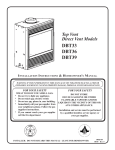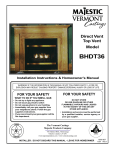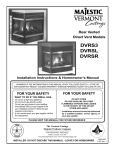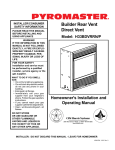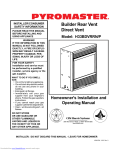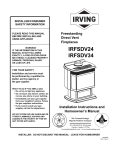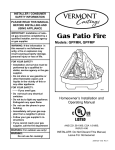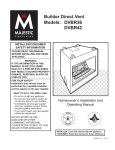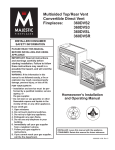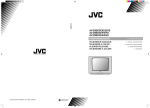Download Vermont Castings RFSDV42 Operating instructions
Transcript
Free-Standing Direct Vented Fireplaces MODEL D232 Installation Instructions & Homeowner's Manual WARNING! IF THE INFORMATION IN THIS MANUAL IS NOT FOLLOWED EXACTLY, A FIRE OR EXPLOSION MAY RESULT CAUSING PROPERTY DAMAGE, PERSONAL INJURY OR LOSS OF LIFE. FOR YOUR SAFETY FOR YOUR SAFETY WHAT TO DO IF YOU SMELL GAS: DO NOT STORE OR USE GASOLINE OR OTHER FLAMMABLE VAPOURS AND LIQUIDS IN THE VICINITY OF THIS OR ANY OTHER APPLIANCE. * * * * Do not try to light any appliance. Do not touch any electric switch Do not use any phone in your building. Immediately call your gas supplier from your neighbours phone. Follow the gas suppliers instructions. * If you cannot reach your gas supplier call the fire department. * INSTALLATION AND SERVICE MUST BE PERFORMED BY A QUALIFIED INSTALLER, SERVICE AGENCY OR YOUR GAS SUPPLIER. INSTALLER: DO NOT DISCARD THIS MANUAL - LEAVE FOR HOMEOWNER -1- 10002735 6/00 Rev. 0 TABLE OF CONTENTS PLEASE READ THE INSTALLATION & OPERATING INSTRUCTIONS BEFORE USING APPLIANCE. IMPORTANT: Read all instructions and warnings carefully before starting installation. Failure to follow these instructions may result in a possible fire hazard and will void the warranty. Installation Instructions.................................................................................................. 3 Important Curing/Burn Information ....................................................................... 3 Locating Your Gas Fireplace ................................................................................ 3 Clearance to Combustibles .................................................................................. 3 Fireplace Dimensions ........................................................................................... 4 Gas Specifications ................................................................................................ 5 Preparation ........................................................................................................... 5 Gas Line Installation ............................................................................................. 5 Installation of Remote Switch for RN/RP gas valve .............................................. 6 General Venting Information .......................................................................................... 7 Termination Clearances ....................................................................................... 8 General Information on Assembling Vent Pipes ................................................... 9 Vertical Sidewall Installations ............................................................................. 10 Vertical Sidewall Applications ............................................................................. 10 Sidewall Venting Graph ...................................................................................... 11 Vent Pipe Assembly ........................................................................................... 12 Below Grade Installations (Snorkel) ................................................................... 13 Vertical Through the Roof Applications .............................................................. 14 To Install Vertical Venting ................................................................................... 15 Crimped Ends Venting Components ........................................................................... 16 Twist Lock Venting Components ................................................................................ 17 Operating Instructions.................................................................................................. 18 General Glass Information .................................................................................. 18 Louvre Removal ................................................................................................. 18 Trim Removal ..................................................................................................... 18 Glass Removal ................................................................................................... 18 Glass Cleaning ................................................................................................... 19 Log Set Installation & Small Lava Rock .............................................................. 19 Ceramic Refractory ............................................................................................. 19 Maintenance ....................................................................................................... 20 Cleaning Procedure ............................................................................................ 20 Flame Adjustment & Characteristics .................................................................. 20 Lighting and Operating Instructions .................................................................... 21 Troubleshooting Gas Control (Honeywell) .......................................................... 22 Troubleshooting Gas Control (SIT Nova 820) .................................................... 23 Replacement Parts List .............................................................................................. 24 Replacement Parts Pictorial ............................................................................... 26 Options ......................................................................................................................... 26 -2- INSTALLATION AND OPERATING INSTRUCTIONS This gas fireplace should be installed by a qualified installer in accordance with local building codes and with current CAN / CGA-B149 (. 1 or .2) Installation codes for Gas Burning Fireplaces and Equipment and CAN/CSA Z 240 .4 Canada. IMPORTANT: PLEASE REVIEW THE FOLLOWING CAREFULLY Remove any plastic from trim parts before turning the fireplace ON. FOR U.S.A Installations follow local codes and/or the current National Fuel Gas Code. ANSI Z223.1. It is normal for fireplaces fabricated of steel to give off some expansion and/or contraction noises during the start up or cool down cycle. Similar noises are found with your furnace heat exchanger or car engine. FOR SAFE INSTALLATION AND OPERATION PLEASE NOTE THE FOLLOWING: 1 . This fireplace gives off high temperatures and should be located out of high traffic areas and away from furniture and draperies. 2. Children and adults should be alerted to the hazards of the high surface temperatures of this fireplace and should stay away to avoid burns or ignition of clothing. 3. Children should be carefully supervised when they are in the same room as your fireplace. 4. Under no circumstances should this fireplace be modified.Parts removed for servicing should be replaced prior to operating the fireplace again. 5. Installation and any repairs to this fireplace should be carried out by a qualified service person. A professional service person should be contacted to inspect this fireplace annually.Make it a practice to have all of your gas fireplaces checked annually. More frequent cleaning may be required due to excess lint and dust from carpeting, bedding material, etc. 6. Control compartments, burners and air passages in this fireplace should be kept clean and free of dust and lint. Make sure that the gas valve and pilot light are turned off before you attempt to clean this fireplace. 7, The venting system(chimney) of this fireplace should be checked at least once a year and if needed your venting system should be cleaned. 8. Keep the area around your fireplace clear of combustible materials, gasoline and other flammable vapour and liquids. This fireplace should not be used as a drying rack for clothing,nor should Christmas stockings or decorations be hung in the area of it. 9. Under no circumstances should any solid fuels (wood,coal,paper or cardboard etc.)be used in this fireplace. 10. The flow of combustion and ventilation air must not be obstructed in any way. 11. When the fireplace is installed directly on carpeting, vinyl tile or any combustible material other than wood, the fireplace must be installed on a metal or wood panel extending the full width and depth of the fireplace. 12. This fireplace requires adequate ventilation and combustion air to operate properly. 13. This fireplaces must not be connected to a chimney flue serving a separate solid fuel burning fireplace. It is not unusual for your gas fireplace to give off some odour the first time it is burned. This is due to the curing of the paint and any undetected oil from the manufacturing process. Please ensure that your room is well ventilated - open all windows. It is recommended that you burn your fireplace for a least six (6) hours the first time you use it. If optional fan kit has been installed, place fan in the "OFF" position during this time. LOCATING YOUR GAS FIREPLACE 12" (305mm) A D 12" (305mm) B C E Fig. 1 A) *Flat on wall corner C) Island E) Flat on wall B) D) *Room divider Cross corner * A & B must maintain a 12" (305mm) clearance between the wall and side glass of fireplace. There is a minimum vertical rise required for the venting which varies depending on the application. The maximum horizontal run also has restrictions. Become familiar with the venting instructions starting on page 7, before starting the installation. CLEARANCE TO COMBUSTIBLES Adequate clearances as listed below must be maintained for servicing and proper operation: Back ............................................. 0" Side ............................................ 12" Floor ............................................. 0" Top ............................................. 36" Corner .................. 0" to Back Edges Vent Pipe ...................................... 1" -3- FIREPLACE DIMENSIONS MODEL D232 A K C DE G I J F H B MODEL D232 A 25" 1/8" 635mm B 24 613mm C 16" 406mm D 20" 508mm E 19" 483mm F 21" 533mm 31 3/4" 806mm H 17 3/4" 451mm I 29 5/8" 752mm J 9" 229mm G 1/2" K 6 165mm L — — M — — N — — -4- PREPARATION GAS SPECIFICATIONS MODEL FUEL MAX. INPUT GAS CONTROL B.T.U.H The use of wall paper adjacent to this fireplace is not recommended, as the high heat given off by this fireplace may adversely effect the binders in the adhesive used to apply the wallpaper. MIN. INPUT B.T.U.H. D232RN Natural Gas Millivolt Hi/Lo 30,000 21,000 D232RP Propane Gas Millivolt Hi/Lo 30,000 22,500 Before beginning, remove the glass door from the fireplace. Also check to make sure there is no hidden damage to the fireplace. Take a minute and plan out the gas, vent and electrical supply. See Glass Removal Section. This appliance may be installed in an aftermarket permanently located, manufactured (mobile) home, where not prohibited by local codes. GAS LINE INSTALLATION When purging gas line, the front glass must be removed. This appliance is only for use with the type of gas indicated on the rating plate. This appliance is not convertible for use with other gases, unless a certified kit is available and used. The gas pipeline can be brought in through the rear of the fireplace as well as the bottom. Knockouts are provided on the bottom behind the valve to allow for the gas pipe installation and testing of any gas connection. It is most convenient to bring the gas line in from the rear right side of the valve, as this allows fan installation or removal without disconnecting the gas line. The installation of your Fireplace must conform with local codes, or in the absence of local codes, with National Fuel Gas Code, ANSI Z223.1 latest edition, or CAN 1 B1-149.1 and .2 Installation Code. (EXCEPTION: Do not derate this appliance for elevations up to 4,500 ft (1,370m). Maintain the manifold pressure at 3.5 inches W.C. for Natural Gas and 10 inches W.C. for LP gas.) The gas line connection can be made with properly tinned 3/8" copper tubing, 3/8" rigid pipe or an approved flex connector. Since some municipalities have some additional local codes, it is always best to consult your local authority and the CAN/CGA- B149 (.1 or .2) installation code. FOR U.S.A Installations consult the current National Fuel Gas Code, ANSI Z223.1 Always check for gas leaks with a mild soap and water solution. Do not use an open flame for leak testing. The gas control is equipped with a captured screw type pressure test point, therefore it is not necessary to provide a 1/8" test point up stream of the control. D232 CERTIFIED TO ANSI.Z21.88b-1999 / CSA 2.33b - M99 Vented Gas Fireplace Heaters GAS INLET & MANIFOLD PRESSURES NATURAL LP (Propane) Input Minimum 4.5" wc 11" wc Input Maximum 7" wc 13" wc 3.5" wc 10" wc Manifold Pressure 1/2" Gas Supply 1/2" X 3/8" Reducer 3/8" Nipple 3/8" X 3/8" Shut Off Valve 3/8" Nipple 3/8" Union 3/8" Nipple TYPICAL GAS LINE CONNECTION Fig. 2 -5- When using copper or flex connector use only approved fittings. Always provide a union when using back iron pipe so that gas line can be easily disconnected for burner or fan servicing. See Fig. 2. See gas specification for pressure details and ratings. INSTALLATION OF REMOTE SWITCH FOR RN/RP GAS VALVE Install on/off switch assembly on either the rear right or left side of the Fireplace. The fireplace valve must not be subjected to any test pressures exceeding 1/2 psi. Isolate or disconnect this or any other gas appliance control from the gas line when pressure testing. 1. Remove the screw at the back of the cabinet top either on the left or the right side of the fireplace. 2. Position switch assembly onto the back of the fireplace, then fasten two screws as shown in Fig. 5. 3. Attach wiring under the clips on the rear casing (Fig. 5) and install wiring through the rear opening of the fireplace before connecting to the valve as shown in Fig. 4. DO NOT USE THIS FIREPLACE IF ANY PART OF THIS FIREPLACE HAS BEEN UNDER WATER. IMMEDIATELY CALL A QUALIFIED SERVICE TECHNICIAN TO INSPECT THE HEATER AND TO REPLACE ANY PART CONTROL WHICH HAS BEEN UNDER WATER. VALVE TPTH THERMOPILE TP TH OT PIL PILOT ADJ TP TH TP TH ON/OFF SWITCH OR MILLIVOLT THERMOSTAT Fig. 4 On/off switch assembly Screw (through existing hole) Screw Clips Wiring for milli-volt gas valves Fig. 5 -6- GENERAL VENTING INFORMATION Your fireplace is approved to be vented either through the side wall, or vertically through the roof. – Only venting components specifically approved and labelled for this fireplace may be used. – Minimum clearances between vent pipes and combustible materials is one (1") inch (25 mm). – Venting terminals shall not be recessed into a wall or siding. – Horizontal venting must be installed on a level plane without any incline or decline. There must not be any obstruction such as bushes, garden sheds, fences, decks or utility buildings within 24" from the front of the termination hood. Do not locate termination hood where excessive snow or ice build up may occur. Be sure to check vent termination area after snow falls, and clear to prevent accidental blockage of venting system. When using snow blowers, make sure snow is not directed towards vent termination area. Location of Vent Termination It is imperative that the vent termination be located observing the minimum clearances as shown on this page. ; ;;;;;; ;;;;;; *Check with local codes or in absence of same with CAN/CGA B149 (.1 or .2) Installation Codes (1991) for Canada or for U.S.A. Installations follow the current National Fuel Gas Code, ANSI Z223.1. N H D V L E B C Fixed Closed F Ope nab le V B B V Openable B V Fixed Closed I G B V J G X V TERMINATION CAP B= C= D= E= F= G= H= ‡ * V G K V X A G GAS METER X AIR SUPPLY INLET clearance above grade, veranda, porch, deck, or balcony [* 12 inches (305mm) minimum] clearance to window or door that may be opened 12" (306mm). clearance to permanently closed window [minimum 12 inches (305mm) recommended to prevent condensation on window] vertical clearance to ventilated soffit located above the termina/ within a horizontal distance of 24 inches (610mm) from the centre-line of the terminal [18 inches (458mm) minimum] clearance to unventilated soffit [12 inches (305mm) minimum clearance to outside comer see next page clearance to inside comer see next page A * not to be installed above a meter/regulator assembly within 36 inches (914mm) horizontally from the centreline of the regulator † M V A A= N RESTRICTED AREA (TERMINATION PROHIBITED) I= clearance to service regulator vent outlet [*72 inches (1828mm) minimum] J = clearance to non-mechanical air supply inlet to building or the combustion air inlet to any other fireplace [ *12 inches (305mm) minimum] K = clearance to a mechanical air supply inlet [* 72 inches (1828mm) minimum] L = † clearance above paved side-walk or a paved driveway located on public property [*84 inches (2133mm) minimum] M = clearance under veranda, porch, deck [*12 inches (305mm) minimum ‡] N = Clearance above a roof shall extend a minimum of 24" (610mm) above the highest point when it passes through the roof surface, and any other obstruciton within a horizontal distance of 18" (450mm). a vent shall not terminate directly above a side-walk or paved driveway which is located between two single family dwellings and serves both dwellings * only permitted if veranda, porch, deck, is fully open on a minimum 2 sides beneath the floor * as specified in CAN/CGA B149 (.1 or .2) Installation Codes (1991) for Canada or for U.S.A. Installations follow the current National Fuel Gas Code, ANSI Z223.1. Note: Local codes or regulations may require different clearances. -7- ;; ;;; ; ;;;; ; ;; ;; ;; ;; Termination Clearances Termination clearances for buildings with combustible and noncombustible exteriors. Inside Corner Recessed Location Outside Corner A= Combustible 6"(152mm) Noncombustible 2"(50mm) A V B= Combustible 6"(152mm) Noncombustible 2"(50mm) V D C C E V B Balcony with perpendicular side wall Balcony with no side wall G V V G= Combustible& Non-Combustible 12"(305mm) C = Maximum depth of 48" (1219mm) for recessed location. H Combustible & Non-Combustible J D = Minimum width for back wall of a recessed location. Combustible 38"(965mm) Noncombustible 24"(610mm) E = Clearance from corner in recessed location. Combustible 6"(152mm) Noncombustible 2"(50mm) H = 24"(610mm) J = 20"(508mm) -8- GENERAL INFORMATION ON ASSEMBLING THE VENT PIPES TWIST LOCK PIPES CRIMPED END PIPES When using twist lock pipe it is not necessary to use sealant at the twist lock joints. Before joining elbows and pipes apply a bead of high temperature sealant to crimped end of elbow or pipe. (Fig. 6). The only areas of the venting that need to be sealed with high temperature silicone sealant are the collars on the fireplace and termination, and the sliding joint of any telescopic vent pipes used in the system. Join pipes and secure joints with three (3) sheetmetal screws. (See Fig. 6) Wipe off excess sealant. There are polished brass decorative rings provided to hide the exposed piping joints. Wrap the brass ring over the joint fitting the stud into the notch and tighten down the 3/8" nut To join the twist lock pipes together, simply align the beads of the male end with the grooves of the female end, then while bringing the pipes together, twist the pipe until the flange on the female end contacts the external flange on the male end. BEAD LOCATION 1" (25mm) FROM CRIMPED END OF PIPE It is recommended that you secure the joints with 3 sheet metal screws however this is not mandatory with twist lock pipe. 1'' (25mm) To make it easier to assemble the joints we suggest putting a lubricant (Vaseline or similar) on the male end of the twist lock pipe. Screw Holes Fig. 6 TWIST LOCK PIPE JOINT CANADIAN INSTALLATIONS: The venting system must be installed in accordance with the current CAN/CGA-B149 (.1 or .2) installation code. U.S.A. INSTALLATIONS: The venting system must conform with local codes and/or the current National Fuel Gas Code, ANSI Z223.1. Screw Holes Only venting components manufactured by The CFM Majestics Products Company may be used. -9- Fig. 7 For each 45 degree elbow installed in the horizontal run, the length of the horizontal run MUST be reduced by 18" (45cm). This does not apply if the 45 degree elbows are installed on the vertical part of the vent system. VERTICAL SIDEWALL INSTALLATIONS Since it is very important that the venting system maintain its balance between the combustion air intake and the flue gas exhaust, certain limitations as to vent configurations apply and must be strictly adhered to. The maximum number of elbow degrees in a system is 270o (See Fig. 8). The graph showing the relationship between vertical and horizontal side wall venting will help to determine the various lengths allowable. Fig. 11a or 11b. Sample: Minimum clearance between vent pipes and combustible materials is one (1") inch (25mm) on top, bottom and sides unless otherwise noted. 1 2 3 4 Total - 90o 45o 45o 90o 270o When vent termination exits through foundations less than 20" below siding outcrop, the vent pipe must flush up with the siding. A 7DVSS must also be used. It is always best to locate the fireplace in such a way that minimizes the number of offsets and horizontal vent length. The horizontal vent run refers to the total length of vent pipe from the flue collar of the fireplace to the face of the outer wall. Fig. 8 Horizontal plane means no vertical rise exists on this portion of the vent assembly. 3 FT (92cm) x VERTICAL SIDEWALL APPLICATIONS 7.5 ft. 2286mm A + B = 17ft. The maximum number of 90 degree elbows per side wall installation is three (3). D232x=12" Fig. 9 For D232 the maximum horizontal run off a minimum 12" vertical rise is 3'. (See Fig. 9) If a 90 degree elbow is used in the horizontal vent run (level height maintained) the maximum horizontal vent length is reduced by 36 inches. Fig. 10. This does not apply if the 90 degree elbows are used to increase or redirect a vertical rise (Fig. 11). Fig. 10 7.5FT (2286m) 20 FT (610cm) Example: According to the chart the maximum horizontal vent length is 20' and if a 90 degree elbow is required in the horizontal vent it must be reduced to 17'. (Fig. 10 Dimension A plus B must not be greater than 17'). PIPE STRAPS EVERY 3' (92cm) PIPE STRAPS EVERY 3' (92cm) FIRESTOP/ZERO CLEARANCE SLEEVE The maximum number of 45 degree elbows permitted per side wall installation is two (2). These elbows can be installed in either the vertical or horizontal run (Fig. 8). Fig. 11 - 10 - SIDEWALL VENTING GRAPH (Dimensions in Feet) TO USE THE VENT GRAPH For FSDV42 30 29 28 27 26 25 24 RFSDV42 ONLY 23 22 EXAMPLE B: 21 If the vertical dimension from the floor of the fireplace is 7 feet (214cm), the horizontal run to the face of the outer wall must not exceed 8-1/2 feet (259cm). 20 19 18 17 SIDEWALL VENTING GRAPH 16 (Dimensions in Feet) 15 14 For D232 13 12 30 eg: A 11 29 10 28 26 25 24 23 22 21 20 19 18 17 16 15 14 13 12 eg: A 11 10 9 8 7 eg: B 6 9 VERTICAL DIMENSION FROM THE FLOOR OF THE FIREPLACE TO THE CENTRE OF THE HORIZONTAL VENT PIPE 27 8 7 5 4 3 3 3 5 6 7 8 9 10 11 12 13 14 15 16 17 18 19 20 HORIZONTAL DIMENSION 5 6 7 8 9 10 11 12 13 14 15 16 17 18 19 20 Fig. 14b SEE PAGE 14 FOR VENTING REQUIREMENTS FOR SNORKELS. 4 4 4 HORIZONTAL DIMENSION 5 3 eg: C 6 VERTICAL DIMENSION FROM THE FLOOR OF THE FIREPLACE TO THE CENTRE OF THE HORIZONTAL VENT PIPE 1. Determine the height of the centre of the horizontal vent pipe exiting through the outer wall. Using this dimension on the Sidewall Vent Graph (Fig. 12 ), locate the point it intersects with the slanted graph line. 2. From the point of this intersection, draw a vertical line to the bottom of the graph. 3. Select the indicated dimension, and position the fireplace in accordance with same. EXAMPLE A: If the vertical dimension from the floor of the fireplace is 11 feet (335cm) the horizontal run to the face of the outer wall must not exceed 14 feet (427cm). Fig. 12 SEE PAGE 13 & 14 FOR VENTING REQUIREMENTS FOR SNORKELS. - 11 - STEP 3 VENT PIPE ASSEMBLY Place fireplace into position. (Fig. 17). Measure the vertical length (X) required from the base of the flue collars to the centre of the wall opening. STEP 1 Locate vent opening on the wall. It may be necessary to first position the fireplace and measure to obtain hole location. Depending on whether the wall is combustible or noncombustible, cut opening to size. Fig. 13 or 15. (For combustible walls first frame in opening. Fig. 14). Vent Opening — Combustible Wall X (240mm) 9-3/8" Fig. 13 9-3/8" (240mm) (framing detail) Fig. 14 Vent Opening — Noncombustible Wall 7-1/2" (190mm) STEP 4 Fig. 15 ;; ;; ; Fig. 17 Apply a bead of silicone to the inner and outer flue collars of the fireplace (Fig. 18) and using appropriate length of pipe section(s) attach to fireplace with three (3) screws. Follow with the installation of the inner and outer elbow, again secure joints as described on page 9. COMBUSTIBLE WALLS (Fig. 13): Cut a 9-3/8"H x 9-3/8"W (240 mm x 240 mm) hole through the exterior wall and frame as shown (Fig. 14). NON-COMBUSTIBLE WALLS (Fig. 14): Hole opening must be 7.5" (190 mm) in diameter. BEAD OF SEALANT STEP 2 Measure wall thickness and cut zero clearance sleeve parts to proper length (MAXIMUM 12"). Assemble sleeve and attach to firestop with #8 sheetmetal screws (supplied). Install firestop assembly (Fig. 16).. Zero clearance sleeve is only required for combustible walls. Fig. 18 #8 Maximum Length 12" (294mm) SCREWS(2) ADJUSTABLE ZERO CLEARANCE SLEEVE #8 SCREWS(2) #8 SCREWS(2) ADJUSTABLE ZERO CLEARANCE SLEEVE FIRESTOP Fig. 16 - 12 - STEP 5 STEP 7 ;; ; ;; ; ;; ;; ;; Apply high temperature sealant to 4" and 7" collars or the termination one inch away from crimped end. Guide the vent terminations 4" and 7" collars into their respective vent pipes. Double check that the vent pipes overlap the collars by 2". Secure the termination to the wall with screws provided and caulk around the wall plate to weatherproof. Measure the horizontal length requirement including a 2" overlap , i.e. from the elbow to the outside wall face plus 2" (or the distance required if installing a second 90) elbow. (Fig. 19). ; ; ; ; X Fig. 19 Always install horizontal venting on a level plane. STEP 6 Fig. 21 Note: If using the charcoal wall plate, Part #52202-CG, and collar, Part #52203-CG, put them in place before putting the pipe sections through the wall. ; ;; ;; ; ; ; ; Support horizontal pipes every 3 feet (91 cm) with metal pipe straps. Use appropriate length of pipe sections - telescopic or fixed - and install. The sections which go through the wall are packaged with the starter kit, and can be cut to suit if necessary. (Fig. 20). Check fireplace to make sure it is levelled and properly positioned. BELOW GRADE INSTALLATIONS When it is not possible to meet the required vent terminal clearances of 12 inches (305mm) above grade level a starter vent kit is recommended. It allows installation depth of down to 7 inches (178mm) below grade level. The 7 inches is measured from the centre of the horizontal vent pipe as it penetrates through the wall. If venting system is installed below ground, we recommend a window well with adequate and proper drainage. Fig. 20 Sealing vent pipe and firestop gaps with high temperature sealant will restrict cold air being drawn in around fireplace. - 13 - Ensure sidewall venting clearances are observed. DO NOT BACK FILL AROUND SNORKEL. SOIL SHOULD NOT BE LESS THAN 4" BELOW SNORKEL. If installing a snorkel a minimum 24" vertical rise is necessary. The maximum horizontal run with the 24" vertical pipe is 36" (915mm). This measurement is taken from the collar of the fireplace to the face of the exterior wall. See vent graph for extended horizontal run if the vertical exceeds 24". FOUNDATION RECESS 1. Establish vent hole through the wall (Fig. 13,14 & 15). 2. Remove soil to a depth of approximately 16" below base of snorkel. Install drain pipe. Install window well (not supplied). Refill hole with 12" of coarse gravel leaving a clearance of approximately 4" below snorkel. See Fig. 22. WATERTIGHT SEAL AROUND PIPE 5. Apply high temperature sealant caulking (supplied) around the 4 and 7 inch snorkel collars. 6. Slide into vent pipe and secure to the wall. VERTICAL THROUGH THE ROOF APPLICATIONS 7. Level the soil so as to maintain a 4" clearance below snorkel. See Fig. 22. MAXIMUM 10 FT (305cm) SNORKEL FIRESTOP SCREWS Fig. 23 If the foundation is recessed, use recess brackets (not supplied) for securing lower portion of the snorkel. Fasten brackets to wall first and then secure to snorkel with self drilling #8 x 1/2 sheet metal screws. It will be necessary to extend the vent pipes out as far as the protruding wall face (Fig. 22). 4. Ensure a watertight seal is made around the vent pipe coming through the wall. 4" CLEARANCE MINIMUM 8 FT./ MAXIMUM 40 FT. VERTICAL RISE GROUND WINDOW WELL GRAVEL 24"/608mm MINIMUM* WALL SCREWS SHEET METAL SCREWS 3. Install vent system. 7" PIPE SNORKEL DRAIN PIPE STRAPS EVERY 3’ (92cm) FOUNDATION WALL * A minimum of 24"/608mm vertical pipe must be installed when using the snorkel kit. * The 22" vertical rise (center to center) of the snorkel may be included for calculation of max. horizontal run. Fig. 24 This Gas Fireplace has been approved for, a) Vertical installations up to 40 feet (12 metres) in height. Up to a 10 ft. horizontal vent run can be installed within the vent system using a maximum of two 90o elbows. (Fig. 24) b) Up to two 45o elbows may be used within the horizontal run. For each 45o elbow used on the horizontal level the maximum horizontal length must be reduced by 18 inches. Fig. 22 Example: Maximum horizontal length 0 45o elbows 10 ft. 1 45o elbows 8.5 ft. 2 45o elbows 7 ft. - 14 - VERTICAL THRU THE ROOF APPLICATIONS TO INSTALL VERTICAL VENTING c) A minimum of an 8 ft. vertical rise. d) Two sets of 45 degree elbow offsets within these vertical installations. From 0 to a maximum of 8 ft. of vent pipe can be used between elbows. (Fig. 25) e) 7DVCS must be used to support offsets. (Fig. 26) This application will require that you first determine the roof pitch and use the appropriate starter kit. (See Venting Components List) 1. Locate your fireplace. 2. Plumb to centre of the (4") flue collar from ceiling above and mark position. 3. Cut opening equal to 9-3/8" x 9-3/8" (240 mm x 240 mm). 4. Proceed to plumb for additional openings through the roof. In all cases, the opening must provide a minimum of 1 inch clearance to the vent pipe, i.e., the hole must be at least 9-3/8" x 9-3/8" (240 mm x 240 mm). 5. Place fireplace into position. 6. Place firestop(s) #7DVFS or Attic Insulation Shield #7DVAIS into position and secure. (Fig. 29) 7. Install roof support (Fig. 27) and roof flashing making sure upper flange of flashing is below the shingles. Fig. 30. 8. Install appropriate pipe sections until above the flashing. (See Fig. 30). 9. Install storm collar and seal around the pipe. 10. Add additional vent lengths for proper height. Fig. 28. 11. Apply high temperature sealant to 4" and 7" collars of vertical vent termination and install. MAX. 8 FEET 2.44m Fig. 25 45° 40'(12m) MAX. 8 FEET 2.44m Fig. 26 TYPICAL 7DVCS APPLICATION 45° Attic Insulation Shield 11" 11" JOIST TYPICAL ROOF SUPPORT APPLICATION Ceiling Installation Fig. 27 11" UPPER FLOOR 11" TYPICAL OFFSET INSTALLATION JOIST VENT TERMINATION STORM COLLAR FIRESTOP SPACER ROOF FLASHING ROOF 2' Min. NAILS (4) ROOF SUPPORT Fig. 29 ATTIC INSULATION Fig. 29 If there is a room above ceiling level, firestop spacer must be installed on both the bottom and the top side of the ceiling joists. If an attic is above ceiling level a 7DVAIS (Attic Insulation Shield) must be installed. CEILING JIOSTS JOISTS 40 FEET (12.2mm) ATTIC INSULATION SHIELD Fig. 30 The enlarged ends of the vent section always face downward. TYPICAL STRAIGHT-UP INSTALLATION SHEETMETAL SCREWS (#5) — 3 PER JOINT SEALANT Fig. 28 STORM COLLAR The minimum height of the vent above the highest point of penetration through the roof is 2 feet. See Fig. 28. SHEETMETAL SCREWS (#5) — 3 PER JOINT SEALANT STORM COLLAR Fig. 30 - 15 - CRIMPED ENDS VENTING COMPONENTS Starter Kit -Model 7DVSK - Sidewall Venting Starter Kit - Model 7TDVSKV - Vertical Venting for 7DVSKV-A order 1/12 to 6/12 roof pitch for 7DVSKV-B order 7/12 to 12/12 roof pitch for 7DVSKV-F order flat roof Starter Kit - Model 7TDVSKS -Snorkel Kit for Below Grade Installation 45º elbow kit 7DVT45 for Vertical Installation Offsets 90º transition elbow kit 7DVRT90 for Vertical Sidewall Applications or thru-the-roof. Telescopic vent sections 7DVP610 6" to 10" adjustable length 7DVP1018 - 10" to 18" adjustable length 7DVP1834 - 18" to 34" adjustable length 7DVP3466 - 34" to 66" adjustable length Pipe sections for vertical or horizontal venting Model 7DVP8" 4 per box Model 7DVP12" 4 per box Model 7DVP24" 4 per box Model 7DVP36" Model 7DVP48" Firestop Spacer Model 7DVFS Attic Insulation Shield Model 7DVAIS Vertical/Horizontal Combination Offset Support Model 7DVCS 7DVSS Siding Shield (to protect siding) - 16 - TWIST LOCK VENTING COMPONENTS Starter Kit -Model 7TDVSK - Sidewall Venting Starter Kit - Model 7TDVSKV - Vertical Venting for 7TDVSKV-A order 1/12 to 6/12 roof pitch for 7TDVSKV-B order 7/12 to 12/12 roof pitch for 7TDVSKV-F order flat roof Starter Kit - Model 7TDVSKS -Snorkel Kit for Below Grade Installation 45º elbow kit 7TDV45 for Vertical Installation Offsets 90º transition elbow kit 7TDVRT90 for Vertical Sidewall Applications or thru-the-roof. Telescopic vent sections 7TDVP1218 - 12" to 18" adjustable length 7TDVP3566 - 35" to 64" adjustable length Pipe sections for vertical or horizontal venting Model 7TDVP8" Model 7TDVP12" Model 7TDVP24" Model 7TDVP36" Model 7TDVP48" Firestop Spacer Model 7DVFS Attic Insulation Shield Model 7DVAIS Vertical/Horizontal Combination Offset Support Model 7DVCS 7DVSS Siding Shield (to protect siding) - 17 - OPERATING INSTRUCTIONS GENERAL GLASS INFORMATION GLASS REMOVAL D232 1 . Remove frame window brass trim (See Trim Removal section) 2. Remove remaining bottom 3/8" nut at the bottom of the frame window. 3. Remove 3/8" nut from each side of the frame window (Fig. 32). 4. Remove frame window by pulling it forward and up. Only glass approved for use in with this product may be used for replacement. 1. The use of substitute glass will void all product warranties. 2. Care must be taken to avoid breakage of the glass. Under no circumstances should this fireplace be operated without the front glass or with a broken glass. Replacement of the glass (with gasket) as supplied by the manufacturer should be done by a licenced qualified service person. GLASS FRAME LOUVRE REMOVAL D232 To remove louvres first remove the two (2) screws (Fig. 31) fastening the louvre assembly to the fireplace. Lift the louvre assembly straight out sliding the back guides out of the fireplace body. (To reinstall, reverse). OUTER NUTS DRAWING 2 DRAWING 1 Front View Side Nuts Screws Fig. 31 BOTTOM NUT TRIM REMOVAL D232 1. Remove the two (2) outer 3/8" nuts holding the frame window brass trim in place. (Fig. 32) 2. Remove the frame window brass trim by moving it straight forward. - 18 - Fig. 32 GLASS CLEANING It will be necessary to clean the glass periodically. During start-up condensation, which is normal, forms on the inside of the glass and causes lint, dust and other airborne particles cling to the glass surface. Also initial paint curing may deposit a slight film on the glass. It is therefore recommended that the glass be cleaned two or three times with a non-ammonia household cleaner and warm water (we recommend gas fireplace glass cleaner). After that the glass should be cleaned two or three times during each heating season depending on the circumstances present. Clean glass after first two weeks of operation. INSTALLATION OF LOGS & BURNER LAVA ROCK MATERIAL D232 1 . Remove front glass. (See "Glass Removal" section) 2. Remove logs from packaging. 3. Place rear log (KR4) on rear bracket (ensure log is seated properly, leveled and centered to the unit), so it will not move from side to side and it is firmly positioned on the bracket. 4. Slip front ember log (KR1) down in the front deflector. 5. Place front left log (KR2) on top burner, left side. Use log's bottom holes to locate it into the left bracket log locator studs. 6. Place front right log (KR3) on top of burner, right side. Use log's bottom holes to locate it into the right bracket log locator studs. 7. Place small lava rocks and ember material on top of burner. (See Fig. 34 for proper location). 8. Place top left log (KR5) onto locator notches. Ensure log is secure. 9. Place top right log (KR6) onto locator notches. Ensure log is secure. Top logs must be placed properly into notches ; ; ;; ;; D232 KR5 KR6 KR4 KR2 KR3 KR1 Burner Lava Rock Placement Fig. 34 - 19 - FLAME ADJUSTMENT (RN/RP MODELS) MAINTENANCE For units equipped with Hi/Lo valves, flame adjustment is accomplished by rotating the Hi/Lo adjustment knob located near the centre of the gas control. (Fig. 38 & 39) 1. It is important to keep the burner and the burner compartment clean. This must be done periodically, at least once per season. (See Cleaning Procedure). 2. Clean the brass trim using a soft clean cloth, slightly dampened with lemon oil and buff with a soft clean cloth. Do NOT use brass polish or household cleaners as these products will damage the brass trim. Lemon oil can be obtained at supermarkets or hardware stores. 3. The optional FK12 and FK24 Fan requires periodic cleaning. Check the fan and the area around the fan assembly and wipe or vacuum at least once per month during the operating season. 4. Contact your local representative to arrange an annual service program. HI Turn counterclockwise to increase flame height. Turn clockwise to lower flame height. LO O H CLEANING PROCEDURE L Turn counterclockwise to decrease flame height. I Fig. 38 Turn clockwise to increase flame height. 1. Turn off pilot light at gas valve. 2. Remove front glass. 3. Remove logs. Fig. 39 CAUTION: LOGS MAY BE HOT FLAME CHARACTERISTICS 4. Vacuum burner compartment especially around orifice/primary air openings. 5. Reinstall logs. 6. Check pilot and main burner operation. 7. Reinstall glass front. 8. Recheck pilot and main burner operation. 9. Check visually the flame pattern and compare with Fig. 39, 40a & b or 41. It is important to periodically perform a visual check of the pilot and the burner flames. Compare them to the pictorials illustrated below (Fig. 40a & b, or 41). If any of the flames appear abnormal call a service person. 3/8" - 1/2" PSE PILOT SIT PILOT Fig. 40a Fig. 40b D232 Fig. 41 - 20 - LIGHTING AND OPERATING INSTRUCTIONS FOR YOUR SAFETY READ BEFORE LIGHTING WARNING: If you do not follow these instructions exactly, a fire or explosion may result causing property damage, personal injury or loss of life. A. This fireplace has a pilot which must be lit manually. When lighting the pilot follow these instructions exactly. BEFORE LIGHTING smell all around the fireplace area for gas. Be sure to smell next to the floor because some gas is heavier than air and will settle on the floor. B. WHAT TO DO IF YOU SMELL GAS • Do not try to light any fireplace. • Do not touch any electric switch • Do not use any phone in your building • Immediately call your gas supplier from a neighbor's phone. Follow the gas supplier's instructions. • If you cannot reach your gas supplier, call the Fire Department C. Use only your hand to push in or turn the gas control knob. Never use tools. If the knob will not push in or turn by hand, do not try to repair it, call a qualified service technician. Applying force or any attempted repair may result in a fire or explosion. D. Do not use this fireplace if any part has been under water. Immediately call a qualified service technician to inspect the fireplace and to replace any part of the control system and any gas control which has been under water. LIGHTING INSTRUCTIONS 1. STOP! Read the safety information above on this page. Turn off all electrical power to the fireplace. For MN/MP/TN/TP appliances ONLY, go on to Step 4. For RN/RP appliances turn the On/Off switch to off position or set thermostat to lowest level. Open control access panel. Push in gas control knob slightly and turn clockwise to "OFF". Do not force. 2. 3. 4. 5. 10. Push the control knob all the way in and hold. Immediately light the pilot by repeatedly depressing the piezo spark ignitor until a flame appears. Continue to hold the control knob in for about one (1) minute after the pilot is lit. Release knob and it will pop back up. Pilot should remain lit. If it goes out, repeat steps 5 through 8. OR PI LO T OFF 7. 8. 9. PI LOT 6. F LO OT EURO SIT ON ON it PIL OF HI OFF SIT NOVA HONEYWELL Wait five (5) minutes to clear out any gas. Then smell for gas, including near the floor. If you smell gas, STOP! Follow "B" in the safety information above on this page. If you don't smell gas, go to the next step. Remove glass door before lighting pilot. (See Glass Frame Removal in manual). Visibly locate pilot by the main burner. Turn knob on gas control counterclockwise to "PILOT". 11. 12. 13. 14. • If knob does not pop up when released, stop and immediately call your service technician or gas supplier. • If after several tries, the pilot will not stay lit, turn the gas control knob to "OFF" and call your service technician or gas supplier. Replace glass door. Turn gas control knob to "On" position. For RN/RP appliances turn the On/Off switch to "On" position or set thermostat to desired setting. Turn on all electrical power to the fireplace. TURNOFF OFF GAS APPLIANCE TOTO TURN GASTO TO FIREPLACE 1. 2. 3. Turn the On/Off switch to Off position or set the thermostat to lowest setting. Turn off all electric power to the fireplace if service is to be performed. Open control access panel. 4. 5. - 21 - Push in gas control knob slightly and turn clockwise to "OFF". Do not force. Close control access panel. TROUBLE SHOOTING THE GAS CONTROL SYSTEM HONEYWELL MILLIVOLT VALVE START CHECK • GAS SUPPLY ON • SUPPLY LINE HOOKED UP • SHUTOFF VALVE OPEN NO • LOCKOUT HAS ENGAGED. WAIT 60 SECONDS AND TRY AGAIN. • FOR SPARK AT ELECTRODE WHILE DEPRESSING PIEZO — 1/8" GAP TO PILOT HOOD NEEDED. • ALL WIRING CONNECTIONS • REPLACE PIEZO IGNITOR YES PILOT LIGHTS WITH PIEZO IGNITOR NO YES PILOT STAYS LIT NO • FOR AIR IN THE LINES • THERMOPILE NEEDS A MINIMUM 325mV. ADJUST PILOT FLAME HEIGHT. • ALL WIRING CONNECTIONS. • REPLACE THERMOPILE • THERMOCOUPLE NEEDS A MINIMUM OF 14mV. • DEFECTIVE VALVE. TURN TO PILOT, METER SHOULD READ GREATER THAN 100 mV. IF NOT, REPLACE. NO • VALVE IS TURNED ON • ON/OFF SWITCH IS NOT TURNED ON. WATCH FOR GROUNDED WIRES! • THERMOPILE NEEDS A MINIMUM 325mV. • PLUGGED BURNER ORIFICE. YES PILOT LIGHTS MAIN BURNER YES SYSTEM OK. - 22 - TROUBLE SHOOTING THE GAS CONTROL SYSTEM SIT NOVA 820 MILLIVOLT VALVE Note: Before trouble shooting the gas control system, be sure external gas shut off is in the "On" position. WARNING: BEFORE DOING ANY GAS CONTROL SERVICE WORK, REMOVE GLASS FRONT. SYMPTOM 1. Spark ignitor will not light. 2. Pilot will not stay lit after carefully following lighting instructions. 3. Pilot burning, no gas to burner. 4. Frequent pilot outage problem. POSSIBLE CAUSES CORRECTIVE ACTION A. Defective or misaligned electrode at pilot. Using a match, light pilot. If pilot lights, turn off pilot and push the red button again. If pilot will not light - check gap at electrode and pilot-should be 1/8" to have a strong spark. B. Defective ignitor (Push Button) Push Piezo Ignitor Button. Check for spark at electrode and pilot. If no spark to pilot, and electrode wire is properly connected, replace ignitor. A. Defective pilot generator (thermocouple), remote wall switch. 1. Check pilot flame. Must impinge on thermocouple/ thermopile. Note: this pilot burner assembly utilizes both a thermocouple and a thermopile. The thermocouple operates the main valve operation (On and Off). Clean and or adjust pilot for maximum flame impingement on thermopile and thermocouple. B. Defective automatic valve operator. Turn valve knob to "Pilot". Maintain flow to pilot; millivolt meter should read greater than 10 mV. If the reading is okay and the pilot does not stay on, replace the gas valve. Note: An interrupter block (not supplied) must be used to conduct this test. A. Wall switch or wires Check wall switch and wires for proper connections. Jumper replace defective wall switch. If okay, jumper wires across wall switch wires at valve, if burner comes on, wires are faulty or connections are bad. B. Thermopile may not be generating sufficient millivoltage. 1. Be sure wire connections from thermopile at gas valve terminals are tight and thermopile is fully inserted into pilot bracket. 2. One of the wall switch wires may be grounded. Remove wall switch wires from valve terminals if pilot now stays lit, trace wall switch wiring for ground. May be grounded to fireplace or gas supply. 3. Check thermopile with millivolt meter. Take reading at thermopile terminals of gas valve. Should read 250-300 millivolts (minimum 150) while holding valve knob depressed in pilot position and wall switch "Off". Replace faulty thermopile if reading is below specified minimum. C. Plugged burner orifice. Check burner orifices for debris and remove. D. Defective automatic valve operator. Turn valve knob to "On", place wall switch to "On" millivolt meter should read greater than 100 mV. If the reading is okay and the burner does not come on, replace the gas valve. A. Pilot flame may be too low or blowing (high) causing the pilot safety to drop out. Clean and/or adjust pilot flame for maximum flame impingement on thermopile and thermocouple. B. Possible blockage of the vent terminal. Check the vent terminal for blockage (recycling the flue gases) - 23 - REPLACEMENT PARTS LIST DESCRIPTION 1. 1a. 1b. 1c. 1d. 1e. 1f. 2. 3a. 3b. 4. 5a. 5b. 6a. 6b. 7a. 7b. 8a. 8b. 9a. 9b. 10a. 10b. 11. 12. 13. 14. 15. 16. 17. 18. 19. 20. 21a. 21b. 22. 23 24a. 24b. 25a. 25b. 26. 27. 28. 29. 30. 31. 32. 33. 36a. 36b. 37. 39. 41. 42. 43. 44. 45. 46. D232 Log Set Complete Log Ember Front Log Front Left Log Front Right Log Rear Log Top Left Log Top Right Burner Lava Rock (Package) Burner with Tiles Nat. Burner with Tiles Prop. Ceramic Tile (Single) Orifice Front Nat. Orifice Front Prop. Orifice Main Nat. Orifice Main Prop. Orifice Pilot SIT Nat. Orifice Pilot SIT Prop. Orifice Pilot PSE Nat. Orifice Pilot PSE Prop. Pilot Assembly SIT Nat. Pilot Assembly SIT Prop. Pilot Assembly PSE Nat. Pilot Assembly PSE Prop. Pilot SIT-Top Convertible Pilot w/ignitor and cable PSE Pilot Tubing w/fittings Manifold Tubing w/fittings Thermocouple SIT Thermocouple PSE Thermopile Electrode Ignitor w/cable SIT Ignitor Piezo SIT Ignitor Piezo Honeywell Valve SIT 820 Nat. Valve SIT 820 Prop. Extension Knob Hi/Lo SIT (RN/RP) Extension Knob On/Off SIT (RN/RP) Valve Honeywell Nat. Valve Honeywell Prop. Valve Eurosit 630 Nat. Valve Eurosit 630 Prop. Fan with Bracket Electrical Cord (6ft.) Fan Temperature Sensor Speed Control Speed Control Knob Glass with Gasket - Front Glass with Gasket - Side Gasket Glass Frame Window - Left Side Frame Window - Right Side Frame Window - Front Trim Frame Window (PB) Top Louvre Front Louvre Assembly Access Door Assembly (with handle) Latch Remote Switch Remote Wire Harness with Terminals 10000160 KR1 KR2 KR3 KR4 KR5 KR5 57897 57903 57904 57803 SEE RATING PLATE FOR ORIFICE SIZE SEE RATING PLATE FOR ORIFICE SIZE SEE RATING PLATE FOR ORIFICE SIZE SEE RATING PLATE FOR ORIFICE SIZE 54273 54272 10001822 10001823 10000674 10000675 10001741 10001742 10001295 10001824 53211 57318 53373 10001825 51827 10001297 52464 20000062 52677 52678 10000165 10000166 10001782 10001759 53448 53446 54103 51865 51704 51738 51882 52035 52032 57316 52145 52860 57244 52027 52019 57908 52030 52057 53606 57265 - 24 - FREESTANDING REPLACEMENT PARTS 9 a/b 4 41 43 42 3a/b 43 43 10 44 11 26 18 17 15 33 32 31 39 33 29 36 a/b 30 13 19 21a,b 7 a/b it OT OF F HI 39 LO 28 22 47 PIL 37 23 5/6 a,b 25a,b 10a/b 12 8 a/b O H PILOT ADJ ON I L PI LO T OFF 40 16 39 2 24a,b 46 20 27 45 41 13 42 #1 - COMPLETE LOG SET 43 1d 1f 1e 1c 1b 1a D232 - 25 - 17 OPTIONS FAN KIT - FK24 Stud It will be easier to install the fan before connecting the gas line to the fireplace. Thermal sensor location 1. Open front access door panel by pulling forward on brass lip. 2. Install the fan through the opening at the back of the pedestal, with the outlet pointed up and the fan mounting bracket facing the back of the fireplace (Fig. 44). . The fan mounts over two studs which hold the fan just below the firebox floor. Hold the fan in place with the two nuts provided. 3. Locate the fan speed control/junction box on screw studs provided on base of the fireplace. Tighten with nuts. 4. Install thermal sensor element on screw studs located to the right of the gas valve on the burner base. 5. Plug in grounded service cord to a convenient wall receptacle. Valve Fan speed control/ Junction box Fan is installed at the back of the pedestal TOP VIEW Fig. 44 Should this fan require servicing, the power supply must be disconnected. For rewiring of any replacement components see Fig. 43. This fan assembly comes completely wired to eliminate the need for electricians. This electrical device, when installed, must be electrically connected and grounded in accordance with local codes. In the absence of local codes, with the current CSA C22.1 CANADIAN ELECTRICAL CODE. REMOTE CONTROL Only for units with RN/RP valve. MRC1 - On/Off Button Remote Control MRC2 - Temperature Control Remote MRC3 - Temperature Control w/digital display & 24 hour programmable clock IMT - Wall Mounted Thermostat For U.S.A. installation: Follow local codes and the NATIONAL ELECTRICAL CODE ANSI/ NFPA No.70-1984. A: SPEED CONTROL B: TEMPERATURE SENSOR C: FAN C B A Black White Ground Fig. 43 - 26 - - 27 - LIMITED WARRANTY & EXTENDED LIFE TIME PROTECTION For Gas Appliance Products* BASIC WARRANTY: The CFM Majestic, Inc.™ (hereinafter referred to collectively as the "Company") warrants that your new Vermont Castings Gas Appliance is free from manufacturing and material defects for a period of one year from date of installation, subject to the following conditions and limitations. EXTENDED LIFE TIME WARRANTY: The heat exchanger, combustion chamber and ceramic burner parts of every *CFM Majestic, Inc. product are warranted for life to the original owner, subject to proof of purchase and the following conditions and limitations: 1. This new CFM Majestic, Inc. product must be installed by a competent, authorized service contractor. It must be installed and operated at all times in accordance with the Installation and Operating instructions furnished with the product. Any alteration, willful abuse, accident, or misuse of the product shall nullify this warranty. 2. This warranty is non-transferrable, and is made to the original owner, provided that the purchase was made through an authorized supplier of the Company. 3. This warranty is limited to the repair or replacement of part(s) found to be defective in material or workmanship, provided that such part(s) have been subjected to normal conditions of use and service, after said defect is confirmed by the Company's inspection. 4. The Company may, at its discretion, fully discharge all obligations with respect to this warranty by refunding the wholesale price of the defective part(s). 5. Any installation, labour, construction, transportation, or other related costs/ expenses arising from defective part(s), repair, replacement, or otherwise of same, will not be covered by this warranty, nor shall the Company assume responsibility for same. Further, the Company will not be responsible for any incidental, indirect, or consequential damages, except as provided by law. 6. All other warranties - expressed or implied - with respect to the product, its components and accessories, or any obligations/liabilities on the part of the Company are hereby expressly excluded. 7. The Company neither assumes, nor authorizes any third party to assume, on its behalf, any other liabilities with respect to the sale of this CFM Majestic, Inc. product. 8. The warranties as outlined within this document do not apply to chimney components or other non CFM Majestic, Inc. accessories used in conjunction with the installation of this product. 9. The Company will not be responsible for . . . a) Down drafts or spillage caused by environmental conditions such as near-by trees, buildings, roof tops, hills, or mountains. b) Inadequate ventilation or negative air pressure caused by mechanical systems such as furnaces, fans, clothes dryers, etc. 10. This warranty is void if: a) The fireplace has been operated in atmospheres contaminated by chlorine, fluorine or other damaging chemicals. b) The fireplace is subjected to prolonged periods of dampness or condensation. c) Any damage to the fireplace, combustion chamber, heat exchanger or other components due to water, or weather damage which is the result of, but not limited to, improper chimney/venting installation. d) Any alteration, willful abuse, accident, or misuse of the product. GLASS DOORS & BRASS PLATED PARTS Glass doors are not warranted for breakage due to misuse or accident. Brass parts should be cleaned with lemon oil only. Brass cleaners cannot be used. Mortar mix and masonry cleaners may corrode the brass finish. The Company will not be responsible for, nor will it warrant any brass parts which are damaged by external chemicals or down draft conditions. IF WARRANTY SERVICE IS NEEDED . . . 1) Contact your supplier. Make sure you have your warranty, your sales receipt, and the model/serial number of your CFM Majestic, Inc. product. 2) DO NOT ATTEMPT TO DO ANY SERVICE WORK YOURSELF. GARANTIE DE BASE: The CFM Majestic. Inc. (aux présentes nommée la "Société") garantit votre nouveau foyer au gaz CFM Majestic, Inc. contre tous défauts de fabrication et de matières premières pour une période d'un an à compter de la date d'installation, sujet aux conditions et limitations suivantes. GARANTIE A VIE PROLONGEE: Les pièces de l'échangeur de chaleur, de la chambre à combustion et du brûleur en céramique de tout produit *CFM Majestic, Inc. sont garanties pour la vie de l'acheteur d'origine, le tout sujet à une preuve d'achat et aux conditions et limitations suivantes: 1. Ce nouveau produit CFM Majestic, Inc. doit être installé par un entrepreneur de service autorisé et compétent. Il doit être installé et utilisé en tout temps selon les instructions d'installation et de fonctionnement fournies avec le produit. Toute altération, abus volontaire, accident ou mauvais usage du produit annulera cette garantie. 2. Cette garantie n'est pas transférable et est offerte à l'acheteur au détail d'origine, à condition que l'achat soit effectué par l'entremise d'un détaillant autorisé de la Société. 3. Cette garantie est limitée à la réparation ou au remplacement de(des) pièce(s) trouvée(s) défectueuse(s) en matières premières ou main-d'oeuvre, à condition que lesdites pièces aient été sujettes aux conditions normales d'usage et de service, après que ledit défaut a été confirmé par une inspection par la Société. 4. La Société peut, à sa discrétion, se décharger entièrement de toutes obligations se rapportant à cette garantie en remboursant le prix de gros de la(des) pièce(s) défectueuse(s). 5. Tous les frais/dépenses d'installation, de main-d'oeuvre, de construction, de transport ou autres causés par une (des) pièce(s) défectueuse(s), une réparation, un remplacement ou autre, ne seront pas couverts sous cette garantie, et la Société n'assume aucune responsabilité pour ceux-ci. De plus, la Société ne pourra être tenue responsable pour tous dommages fortuits ou indirects sauf la ou prévu par la loi. 6. Toutes autres garanties, exprimées ou sous-entendues, en ce qui a trait au produit, ses composants et accessiores, ou toutes obligations/responsabilités de la part de la Société sont aux présentes expressment excluses. 7. La Société n'assume et n'autorise personne à assumer, en son nom, toutes responsabilités en ce qui a trait à la vente de ce produit CFM Majestic, Inc.. 8. Les garanties, telles que décrites dans ce document, ne s'appliquent pas aux compasants de cheminée ou aux autres accessoires non CFM Majestic, Inc. utilisés conjointement pour l'installation de ce produit. 9. La Société n'encourrera aucune responsabilité pour . . . a) Les refoulements de cheminées ou débordements causés par les conditions environnementales comme par les arbres, les édifices, les toits, les côteaux ou les montagnes adjacents. b) Une ventilation inadéquate ou une pression d'air négative causée par des systèmes mécaniques comme les fournaises, les ventilateurs, les sécheuses, etc. 10. Cette garantie est nulle si: a) Le foyer a été utilisé dans une atmosphère contaminée par du chlore, du fluor ou tous autres produits chimiques. b) Le foyer est assujetti à de longues périodes d'humidité ou de condensation. c) Des dommages sont causés au foyer, à la chambre de combustion. à l'échangeur de chaleur ou aux autres composants par de l'eau ou par la température qui est le résultat mais sans y être limité, d'une mauvaise installation de cheminée/ventilation. d) Toute altération, abus volontaire, accident ou mauvais usage du produit annulera cette garantie. PORTES EN VERRE & PIECES PLAQUEES LAITON Les portes en verre ne sont pas garanties contre le bris causé par un mauvais usage ou un accident. Les pièces en laiton devraient être nettoyées qu'avec de l'essence de citron. Les nettoyeurs de laiton ne peuvent pas être utilisés. La Société ne sera pas responsable pour, et ne garantit pas les pièces en laiton qui sont endommagées par des conditions chimiques externes ou de refoulement. 1. 2. SI UN SERVICE SOUS GARANTIE EST REQUIS . . . Communiquez avec votre détaillant. Assurez-vous que vous avez votre garantie, votre reçu de caisse ainsi que le numéro de modèle/série de votre produit CFM Majestic, Inc. NE TENTEZ PAS D'EFFECTUER DES REPARATIONS VOUS-MEME. CFM Majestic, Inc. 410 Admiral Blvd. • Mississauga, Ontario, Canada L5T 2N6 • 905-670-7885 www.vermontcastings.com - 28 - © Copyright CFM Majestic, Inc. 10002735 6/00






























